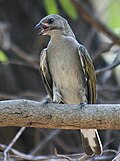Superregnum: Eukaryota
Regnum: Animalia
Subregnum: Eumetazoa
Cladus: Bilateria
Cladus: Nephrozoa
Superphylum: Deuterostomia
Phylum: Chordata
Cladus: Craniata
Subphylum: Vertebrata
Infraphylum: Gnathostomata
Superclassis: Tetrapoda
Cladus: Reptiliomorpha
Cladus: Amniota
Classis: Reptilia
Cladus: Eureptilia
Cladus: Romeriida
Subclassis: Diapsida
Cladus: Sauria
Infraclassis: Archosauromorpha
Cladus: Crurotarsi
Divisio: Archosauria
Subsectio: Ornithodira
Subtaxon: Dinosauromorpha
Cladus: Dinosauria
Ordo: Saurischia
Cladus: Theropoda
Cladus: Neotheropoda
Infraclassis: Aves
Cladus: Euavialae
Cladus: Avebrevicauda
Cladus: Pygostylia
Cladus: Ornithothoraces
Cladus: Euornithes
Cladus: Ornithuromorpha
Cladus: Ornithurae
Cladus: Carinatae
Parvclassis: Neornithes
Cohors: Neognathae
Ordo: Piciformes
Familia: Indicatoridae
Genus: Indicator
Species: I. archipelagicus – I. conirostris – I. exilis – I. indicator – I. maculatus – I. meliphilus – I. minor – I. pumilio – I. variegatus – I. willcocksi – I. xanthonotus
Name
Indicator Stephens, 1815
References
Stephens, J.F. 1815. General Zoology vol. 9, pt. 1, p. 131. Reference page.
Indicator is a genus of near passerine birds in the honeyguide family. The name refers to the behaviour of some species, notably the greater honeyguide, which guide humans to bee colonies so that they can share in the spoils of wax and insects when the nest is broken into.
Indicator honeyguides are brood parasites which lay eggs in a nest of another species, in a series of about five during five to seven days. Most favour hole-nesting species, often the related barbets and woodpeckers. Nestlings have been known to physically eject their host's chicks from the nest, and they have hooks on their beaks with which they puncture the hosts' eggs or kill the nestlings, by repeated lacerations if not a fatal stab.
Species
The species in genus Indicator, in taxonomic order, are:
| Image | Scientific name | Common Name | Distribution |
|---|---|---|---|
| Indicator maculatus | Spotted honeyguide | Angola, Benin, Cameroon, Central African Republic, Republic of the Congo, Democratic Republic of the Congo, Ivory Coast, Equatorial Guinea, Gabon, Gambia, Ghana, Guinea, Guinea-Bissau, Liberia, Mali, Nigeria, Senegal, Sierra Leone, South Sudan, Togo, and Uganda. | |
 |
Indicator variegatus | Scaly-throated honeyguide | Angola, Burundi, DRC, Ethiopia, Kenya, Malawi, Mozambique, Rwanda, Somalia, South Africa, South Sudan, Swaziland, Tanzania, Uganda, Zambia, and Zimbabwe. |
 |
Indicator indicator | Greater honeyguide | sub-Saharan Africa |
| Indicator archipelagicus | Malaysian honeyguide | western Thailand, Peninsular Malaysia, Borneo and the island of Sumatra. | |
 |
Indicator minor | Lesser honeyguide | Angola, Benin, Botswana, Burkina Faso, Burundi, Cameroon, Central African Republic, Chad, Republic of the Congo, Democratic Republic of the Congo, Ivory Coast, Equatorial Guinea, Eritrea, Ethiopia, Gabon, Gambia, Ghana, Guinea, Guinea-Bissau, Kenya, Lesotho, Liberia, Malawi, Mali, Mozambique, Namibia, Niger, Nigeria, Rwanda, Senegal, Sierra Leone, Somalia, South Africa, Sudan, Swaziland, Tanzania, Togo, Uganda, Zambia, and Zimbabwe. |
 |
Indicator conirostris | Thick-billed honeyguide | West, Central and East Africa. |
| Indicator willcocksi | Willcocks's honeyguide | Cameroon, Central African Republic, Republic of the Congo, Democratic Republic of the Congo, Ivory Coast, Equatorial Guinea, Gabon, Ghana, Guinea-Bissau, Liberia, Nigeria, Rwanda, Sierra Leone, and Uganda. | |
| Indicator exilis | Least honeyguide | Angola, Cameroon, Central African Republic, Republic of the Congo, Democratic Republic of the Congo, Ivory Coast, Equatorial Guinea, Gabon, Ghana, Guinea, Guinea-Bissau, Kenya, Liberia, Nigeria, Rwanda, Sierra Leone, South Sudan, Tanzania, Togo, Uganda, and Zambia. | |
| Indicator pumilio | Dwarf honeyguide | Democratic Republic of the Congo, Rwanda, Uganda, and possibly Burundi. | |
| Indicator meliphilus | Pallid honeyguide | Angola, Democratic Republic of the Congo, Kenya, Malawi, Mozambique, Tanzania, Uganda, Zambia, and Zimbabwe. | |
 India 17.02.2016, crop.jpg" decoding="async" srcset="//upload.wikimedia.org/wikipedia/commons/thumb/0/04/Yellow-rumped_Honeyguide_Khangchendzonga_National_Park_West_Sikkim_Sikkim_India_17.02.2016%2C_crop.jpg/180px-Yellow-rumped_Honeyguide_Khangchendzonga_National_Park_West_Sikkim_Sikkim_India_17.02.2016%2C_crop.jpg 1.5x, //upload.wikimedia.org/wikipedia/commons/thumb/0/04/Yellow-rumped_Honeyguide_Khangchendzonga_National_Park_West_Sikkim_Sikkim_India_17.02.2016%2C_crop.jpg/240px-Yellow-rumped_Honeyguide_Khangchendzonga_National_Park_West_Sikkim_Sikkim_India_17.02.2016%2C_crop.jpg 2x" data-file-width="281" data-file-height="297" height="127" width="120" /> India 17.02.2016, crop.jpg" decoding="async" srcset="//upload.wikimedia.org/wikipedia/commons/thumb/0/04/Yellow-rumped_Honeyguide_Khangchendzonga_National_Park_West_Sikkim_Sikkim_India_17.02.2016%2C_crop.jpg/180px-Yellow-rumped_Honeyguide_Khangchendzonga_National_Park_West_Sikkim_Sikkim_India_17.02.2016%2C_crop.jpg 1.5x, //upload.wikimedia.org/wikipedia/commons/thumb/0/04/Yellow-rumped_Honeyguide_Khangchendzonga_National_Park_West_Sikkim_Sikkim_India_17.02.2016%2C_crop.jpg/240px-Yellow-rumped_Honeyguide_Khangchendzonga_National_Park_West_Sikkim_Sikkim_India_17.02.2016%2C_crop.jpg 2x" data-file-width="281" data-file-height="297" height="127" width="120" /> |
Indicator xanthonotus | Yellow-rumped honeyguide | Nepal, Sikkim, Arunachal Pradesh and Bhutan |
References
Barlow, Clive; Tim Wacher & Tony Disley (1997). A Field Guide to the Birds of the Gambia and Senegal. A. & C. Black (Publishers) Ltd. ISBN 1-873403-32-1.
Retrieved from "http://en.wikipedia.org/"
All text is available under the terms of the GNU Free Documentation License

